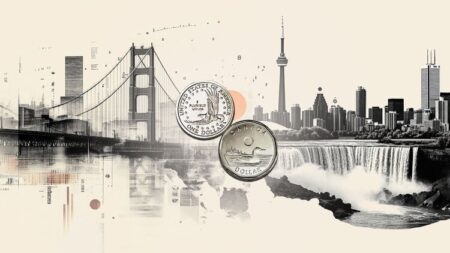- The Australian Dollar strengthens as the US Dollar attracts sellers due to rising US economic concerns.
- However, the AUD may lose its ground as the RBA could deliver further rate cuts.
- The US fiscal deficit could increase if Trump’s “One Big Beautiful Bill” passes the Senate.
The Australian Dollar (AUD) continues to gain ground against the US Dollar (USD) on Monday, marking fresh six-month highs. The AUD/USD pair receives support as the US Dollar remains under downward pressure amid rising uncertainty surrounding the United States (US) economy.
The AUD’s upside could be restrained due to dovish sentiment surrounding the Reserve Bank of Australia’s (RBA) policy outlook. Following the previous week’s 25 basis points interest rate cut by the RBA, Governor Michele Bullock mentioned that the central bank is prepared to take additional action if the economic outlook deteriorates sharply, raising the prospect of future rate cuts.
The Aussie Dollar gained support from renewed optimism surrounding a 90-day US-China trade truce and hopes for further trade deals with other countries. However, the Reserve Bank of Australia will closely monitor further developments on US-China trade negotiations, as China is a major trading partner of Australia.
Traders will keep an eye on Australia-China relations as China’s ambassador has criticised Australia’s plan to renege Darwin Port lease. The port was leased to the Chinese company Landbridge in 2015 for 99 years. The Chinese embassy called this decision an unfair and unethical move, per Reuters.
Australian Dollar appreciates as US Dollar struggles due to fears over rising fiscal deficit
- The US Dollar Index (DXY), which tracks the US Dollar (USD) against a basket of six major currencies, is extending its losses and trading around 98.70. The Greenback struggles amid rising uncertainty surrounding the US economy. US markets will be closed due to the Memorial Day holiday.
- The US fiscal deficit could increase further when Trump’s “One Big Beautiful Bill” goes through the Senate floor, increasing the risk of bond yields staying higher for longer. Higher bond yields can keep borrowing costs higher for consumers, businesses, and governments.
- Trump’s bill is expected to increase the deficit by $3.8 billion, as it would deliver tax breaks on tip income and US-manufactured car loans, according to the Congressional Budget Office (CBO).
- Chicago Federal Reserve (Fed) President Austan Goolsbee said on Friday that Trump’s latest tariff threats likely postpone changes to interest rates. Meanwhile, Kansas City Fed President Jeffrey Schmid noted that policymakers will gauge hard data before formulating interest rate decisions, and the Fed needs to be careful how much emphasis it puts on soft data.
- Fed Governor Christopher Waller noted on Thursday that markets are monitoring fiscal policy. Waller further stated that if tariffs are close to 10%, the economy would be in good shape for H2, and the Fed could be in a position to cut later in the year.
- The US Dollar continues to struggle after Moody’s downgraded the US credit rating from Aaa to Aa1. This move aligns with similar downgrades by Fitch Ratings in 2023 and Standard & Poor’s in 2011. Moody’s now projects US federal debt to climb to around 134% of GDP by 2035, up from 98% in 2023, with the budget deficit expected to widen to nearly 9% of GDP. This deterioration is attributed to rising debt-servicing costs, expanding entitlement programs, and falling tax revenues.
- China’s Commerce Ministry said last week that US measures on China’s advanced chips are ‘typical of unilateral bullying and protectionism’ and impede the stability of the global semiconductor industry chain and supply chain. Chinese authorities asked the United States to swiftly correct its wrong practices.
Australian Dollar rises above 0.6500; posts fresh six-month highs
AUD/USD is trading around 0.6530 on Monday with a persistent bullish bias. Daily technical indicators suggest that the pair rises above the nine-day Exponential Moving Average (EMA), while the 14-day Relative Strength Index (RSI) advances toward the 70 mark, both supporting an upward outlook.
The AUD/USD pair has broken above the previous six-month high of 0.6515, recorded on December 2, 2024. This successful breach would provide support for the pair to approach the seven-month high at 0.6687, recorded in November 2024.
On the downside, the nine-day EMA of 0.6456 would act as an immediate support, followed by the 50-day EMA near 0.6378. The decisive break below these levels would weaken the short- and medium-term price momentum and open the doors for the pair to navigate the region around 0.5914, the lowest since March 2020.
AUD/USD: Daily Chart
Australian Dollar PRICE Today
The table below shows the percentage change of Australian Dollar (AUD) against listed major currencies today. Australian Dollar was the strongest against the US Dollar.
| USD | EUR | GBP | JPY | CAD | AUD | NZD | CHF | |
|---|---|---|---|---|---|---|---|---|
| USD | -0.39% | -0.42% | -0.11% | -0.25% | -0.56% | -0.62% | -0.12% | |
| EUR | 0.39% | -0.03% | 0.32% | 0.14% | -0.17% | -0.22% | 0.28% | |
| GBP | 0.42% | 0.03% | 0.02% | 0.17% | -0.14% | -0.19% | 0.33% | |
| JPY | 0.11% | -0.32% | -0.02% | -0.15% | -0.47% | -0.58% | -0.02% | |
| CAD | 0.25% | -0.14% | -0.17% | 0.15% | -0.29% | -0.36% | 0.15% | |
| AUD | 0.56% | 0.17% | 0.14% | 0.47% | 0.29% | -0.09% | 0.47% | |
| NZD | 0.62% | 0.22% | 0.19% | 0.58% | 0.36% | 0.09% | 0.52% | |
| CHF | 0.12% | -0.28% | -0.33% | 0.02% | -0.15% | -0.47% | -0.52% |
The heat map shows percentage changes of major currencies against each other. The base currency is picked from the left column, while the quote currency is picked from the top row. For example, if you pick the Australian Dollar from the left column and move along the horizontal line to the US Dollar, the percentage change displayed in the box will represent AUD (base)/USD (quote).
US-China Trade War FAQs
Generally speaking, a trade war is an economic conflict between two or more countries due to extreme protectionism on one end. It implies the creation of trade barriers, such as tariffs, which result in counter-barriers, escalating import costs, and hence the cost of living.
An economic conflict between the United States (US) and China began early in 2018, when President Donald Trump set trade barriers on China, claiming unfair commercial practices and intellectual property theft from the Asian giant. China took retaliatory action, imposing tariffs on multiple US goods, such as automobiles and soybeans. Tensions escalated until the two countries signed the US-China Phase One trade deal in January 2020. The agreement required structural reforms and other changes to China’s economic and trade regime and pretended to restore stability and trust between the two nations. However, the Coronavirus pandemic took the focus out of the conflict. Yet, it is worth mentioning that President Joe Biden, who took office after Trump, kept tariffs in place and even added some additional levies.
The return of Donald Trump to the White House as the 47th US President has sparked a fresh wave of tensions between the two countries. During the 2024 election campaign, Trump pledged to impose 60% tariffs on China once he returned to office, which he did on January 20, 2025. With Trump back, the US-China trade war is meant to resume where it was left, with tit-for-tat policies affecting the global economic landscape amid disruptions in global supply chains, resulting in a reduction in spending, particularly investment, and directly feeding into the Consumer Price Index inflation.
Read the full article here
















